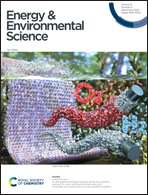Thermo-electrochemical cells for heat to electricity conversion: from mechanisms, materials, strategies to applications
Abstract
Abundant and ubiquitous thermal heat called low-grade heat (<150 °C) is wasted in our surroundings owing to the lack of effective and low-cost energy technologies. Thermo-electrochemical cells (TECs), mainly containing thermogalvanic cells and thermally charged capacitors, are one of the most promising candidates for heat to electricity conversion. They have been intensively investigated owing to the giant thermopower, intrinsic flexibility, low cost and good scalability. To date, great progress such as the giant thermopower (−37 mV K−1), large figure-of-merit (3.74) and high efficiency (11.1%) has been made for TECs. In addition, some functionalized TECs including flexible, stretchable, self-healable and antifreeze TECs have also been developed. However, it is still a great challenge to develop such TECs that combine high power density and efficiency as well as multifunction abilities for practical applications, particularly the thermogalvanic cells (which can continuously output electricity). Herein, we comprehensively summarized TECs from foundations to materials, strategies to engineering designs and opportunities to challenges, expecting to promote the development of TECs toward more superior performance and practicability.



 Please wait while we load your content...
Please wait while we load your content...